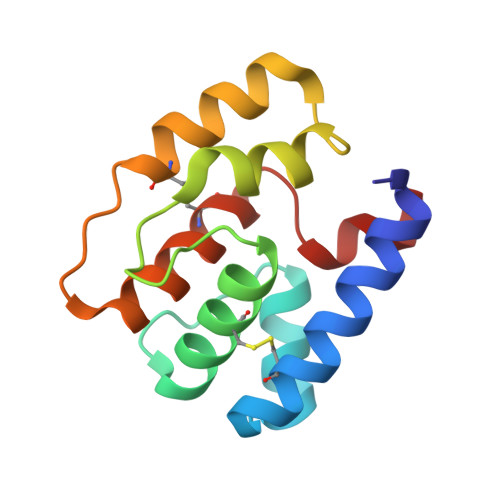Crystal structure of Apis mellifera OBP14, a C-minus odorant-binding protein, and its complexes with odorant molecules.
Spinelli, S., Lagarde, A., Iovinella, I., Legrand, P., Tegoni, M., Pelosi, P., Cambillau, C.(2012) Insect Biochem Mol Biol 42: 41-50
- PubMed: 22075131
- DOI: https://doi.org/10.1016/j.ibmb.2011.10.005
- Primary Citation of Related Structures:
3RZS, 3S0A, 3S0B, 3S0D, 3S0E, 3S0F, 3S0G - PubMed Abstract:
Apis mellifera (Amel) relies on its olfactory system to detect and identify new-sources of floral food. The Odorant-Binding Proteins (OBPs) are the first proteins involved in odorant recognition and interaction, before activation of the olfactory receptors. The Amel genome possess a set of 21 OBPs, much fewer compared to the 60-70 OBPs found in Diptera genomes. We have undertaken a structural proteomics study of Amel OBPs, alone or in complex with odorant or model compounds. We report here the first 3D structure of a member of the C-minus class OBPs, AmelOBP14, characterized by only two disulfide bridges of the three typical of classical OBPs. We show that AmelOBP14 possesses a core of 6 α-helices comparable to that of classical OBPs, and an extra exposed C-terminal helix. Its binding site is located within this core and is completely closed. Fluorescent experiments using 1-NPN displacement demonstrate that AmelOBP14 is able to bind several compounds with sub micromolar dissociation constants, among which citralva and eugenol exhibit the highest affinities. We have determined the structures of AmelOBP14 in complex with 1-NPN, eugenol and citralva, explaining their strong binding. Finally, by introducing a double cysteine mutant at positions 44 and 97, we show that a third disulfide bridge was formed in the same position as in classical OBPs without disturbing the fold of AmelOBP14.
Organizational Affiliation:
Architecture et Fonction des Macromolécules Biologiques, UMR 6098 CNRS and Universités of Marseille, 163 Av. de Luminy Case 932, 13288 Marseille Cedex 09, France.















